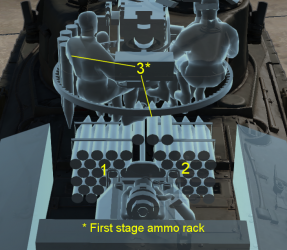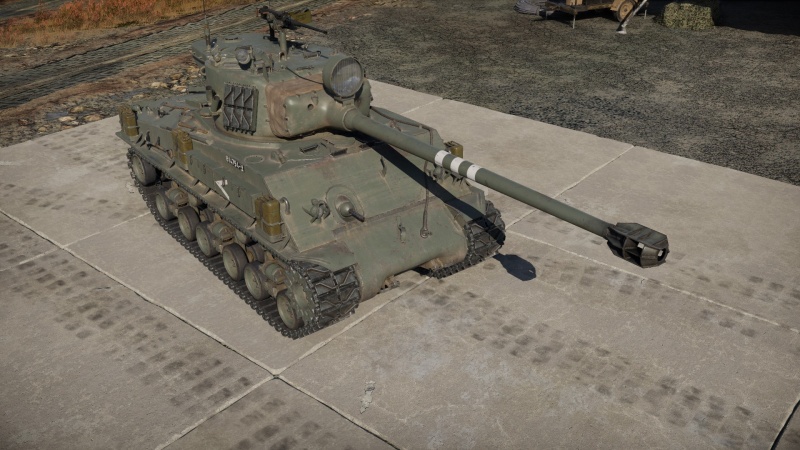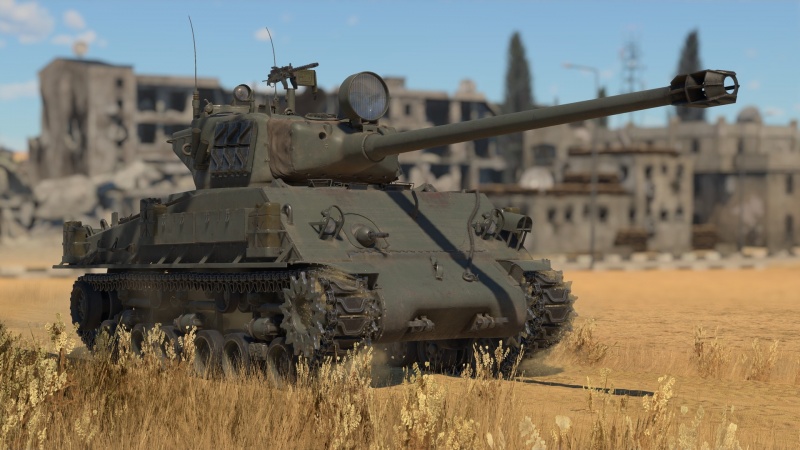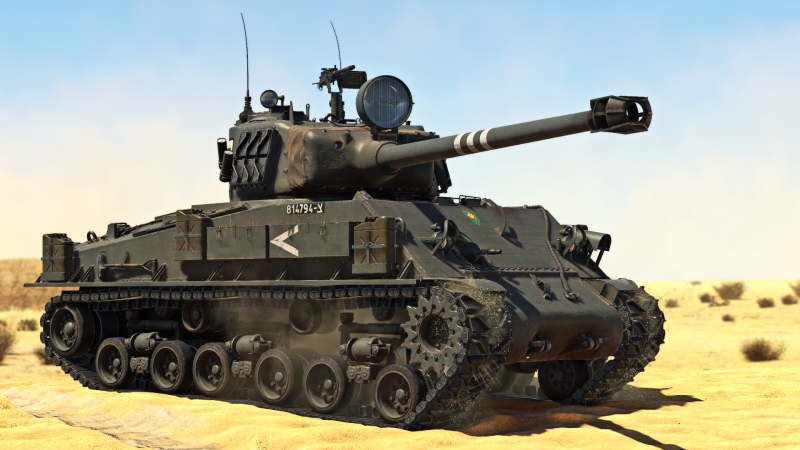Difference between revisions of "M-51 (W)"
m (U38088265 moved page M-51 to M-51 (M4A3)) |
m (U38088265 moved page M-51 (M4A3) to M-51 over a redirect without leaving a redirect: revert) |
(No difference)
| |
Revision as of 20:17, 25 March 2022
Contents
Description
The M-51 (W) is a premium gift rank IV Israeli medium tank with a battle rating of 6.0 (AB/RB/SB). It was introduced in Update "Winged Lions".
General info
Survivability and armour
While the Sherman had decent armour for its time, its armour will be penetrated by most enemies it will face at this rank. That's why you should adopt a playstyle similar to the Pz.IV F2: rely on your gun and mobility and keep distance between you and the enemy vehicles.
Armour type:
- Rolled homogeneous armour (Hull)
- Cast homogeneous armour (Turret, Transmission area, Cupola, MG port)
| Armour | Front (Slope angle) | Sides | Rear | Roof |
|---|---|---|---|---|
| Hull | 63.5 mm (48-57°) Upper glacis 25.4 mm (spherical) MG port 63.5-107.9 mm (cylindrical) Transmission housing 63.5 mm (53°) Lower glacis |
38.1 mm | 38.1 mm (21°) Upper plate 38.1 mm (14-44°) Lower glacis |
63.5 mm (23-42°) Front glacis 19.5 mm Crew compartment 19.5 mm (8-24°) Engine compartment 9.5 mm Vents |
| Turret | 51 mm (13°) Turret front 100 mm Gun mantlet |
51 mm (0-13°) | 51 mm (55-64°) | 25.4 mm |
| Cupola | 63.5 mm (Conical) | 25.4 mm | ||
Notes:
- Suspension wheels are 15 mm thick, tracks are 20 mm thick, and torsion bars are 10 mm thick.
Mobility
| Game Mode | Max Speed (km/h) | Weight (tons) | Engine power (horsepower) | Power-to-weight ratio (hp/ton) | |||
|---|---|---|---|---|---|---|---|
| Forward | Reverse | Stock | Upgraded | Stock | Upgraded | ||
| Arcade | 43 | 6 | 40 | 713 | 878 | 17.83 | 21.95 |
| Realistic | 38 | 5 | 407 | 460 | 10.18 | 11.5 | |
Modifications and economy
Armaments
Main armament
| 105 mm M-51 | Turret rotation speed (°/s) | Reloading rate (seconds) | |||||||||||
|---|---|---|---|---|---|---|---|---|---|---|---|---|---|
| Mode | Capacity | Vertical | Horizontal | Stabilizer | Stock | Upgraded | Full | Expert | Aced | Stock | Full | Expert | Aced |
| Arcade | 56 | -8°/+20° | ±180° | N/A | 22.8 | 31.6 | 38.4 | 42.5 | 45.2 | 9.75 | 8.63 | 7.95 | 7.50 |
| Realistic | 14.3 | 16.8 | 20.4 | 22.6 | 24.0 | ||||||||
Ammunition
| Penetration statistics | |||||||
|---|---|---|---|---|---|---|---|
| Ammunition | Type of warhead |
Penetration @ 0° Angle of Attack (mm) | |||||
| 10 m | 100 m | 500 m | 1,000 m | 1,500 m | 2,000 m | ||
| OCC 105 F1 | HEAT | 400 | 400 | 400 | 400 | 400 | 400 |
| OE 105 F1 Mle.60 | HE | 25 | 25 | 25 | 25 | 25 | 25 |
| Shell details | |||||||||
|---|---|---|---|---|---|---|---|---|---|
| Ammunition | Type of warhead |
Velocity (m/s) |
Projectile Mass (kg) |
Fuse delay (m) |
Fuse sensitivity (mm) |
Explosive Mass (TNT equivalent) (g) |
Ricochet | ||
| 0% | 50% | 100% | |||||||
| OCC 105 F1 | HEAT | 800 | 10.95 | 0.05 | 0.1 | 1,020 | 62° | 69° | 73° |
| OE 105 F1 Mle.60 | HE | 800 | 12.1 | 0 | 0.1 | 2,000 | 79° | 80° | 81° |
| Smoke shell characteristics | ||||||
|---|---|---|---|---|---|---|
| Ammunition | Velocity (m/s) |
Projectile Mass (kg) |
Screen radius (m) |
Screen deploy time (s) |
Screen hold time (s) |
Explosive Mass (TNT equivalent) (g) |
| OFPH 105 F1 | 600 | 11.4 | 20 | 5 | 25 | 50 |
Ammo racks

| Full ammo |
1st rack empty |
2nd rack empty |
3rd rack empty |
Visual discrepancy |
|---|---|---|---|---|
| 56 | 33 (+23) | 9 (+47) | 1 (+55) | No |
Notes:
- Shells are modeled individually and disappear after having been shot or loaded.
- Rack 3 is a first stage ammo rack. It totals 8 shells and gets filled first when loading up the tank.
- This rack is also emptied early: the rack depletion order at full capacity is: 3 - 1 - 2.
- Simply not firing when the gun is loaded will move ammo from racks 1 and 2 into rack 3. Firing will interrupt the restocking of the ready rack.
Machine guns
| 7.62 mm M1919A4 | ||||
|---|---|---|---|---|
| Mount | Capacity (Belt) | Fire rate | Vertical | Horizontal |
| Coaxial | 4,750 (250) | 500 | N/A | N/A |
| Pintle | 600 (250) | 500 | -10°/+60° | ±180° |
Usage in battles
As stated above, the armor of the M-51 is very weak, so your best chance is to try to snipe enemy targets from a long distance. If the tank has to fight in close-ranges, one advantage the M-51 has is a rather fast turret traverse rate, so it could respond quickly to enemies approaching from its sides. Even in realistic mode, the tank has a decently fast reload speed so try to get the enemy to fire then carefully go around the corner.
Pros and cons
Pros:
- Impressive firepower
- Great long range cannon
- Wide FOV in the gunner's sight
- Quick turret traverse
- 4 turret-mounted smoke grenades
Cons:
- Massive gun wobbling: the gun is not stabilised and bounces a lot
- Poor top speed and acceleration
- With its poor armour and massive gun, close quarters combat is not recommended
- Cramped turret due to the large breech
- Fires only chemical based HEAT and HE shells
- The HEAT shell has low muzzle velocity and unreliable post-penetration damage, aiming at ammunition and crew positions is necessary
- The large muzzle brake catches a lot of shells, destroying the gun
- Only has .30 cal machine guns
History
Upon its establishment in 1948, the Israeli Defense Force (IDF) was desperate to set up an armoured corps in order to contend with the multi-pronged Arab invasion. World War II surplus early-model M4 Sherman tanks, many of them already rendered combat-ineffective, were purchased from any European source that would provide them. A significant Israeli repair effort finally managed to get most of these tanks working in time to defeat the invading armoured battalions, ultimately winning the war. The basic M4 remained the IDF's primary tank for more than half a decade, precisely because it was considered obsolete everywhere else and could therefore be purchased en-masse at scrapyard prices. During the early 1950s it was slowly replaced with more advanced Sherman models, whenever those could be acquired.
Unfortunately for the IDF, this situation could not continue for long. Newfound cooperation between the Arab states and the Soviet Union resulted in an influx of T-34-85s into the region, whose armour was very difficult to penetrate using the M4's original 75 mm M3 cannon. It was obvious that the Shermans would need to be replaced in order to keep up with the arms race. Initially, the IDF considered purchasing the new AMX-13 from France (which was rapidly becoming Israel's primary weapon supplier), but the tank was determined to be too lightly armoured. Instead, a number of French CN-75-50 cannons (also known as the SA50 L/57) were purchased separately and installed into the turrets of existing M4A4 Shermans. This resulted in the Sherman M-50, known abroad as the "Super Sherman" and in War Thunder as the M4A4 (SA50).
The M-50s proved highly effective during the Sinai War of 1956, but the lessons of that war resulted in the Soviets flooding the region - particularly Egypt and Syria - with the newest T-54/55, armed with a 100 mm cannon and carrying more modern curved armour. Once again, new French AMX-30s were rejected as replacements for the M-50, but their new CN-105-F1 105 mm cannons proved quite suitable for the IDF's purposes. The Israelis modified these cannons to their own specifications, slightly reducing barrel length and muzzle velocity as well as fitting the cannon with a brand new muzzle brake. This modified cannon would be installed on an M4A1 Sherman hull fitted with a T23 turret (the turret originally used for 76 mm Sherman variants). The tank was then fitted with a number of additional modernization features, including infrared spotlights and a better fire control system.
This new model was dubbed the Sherman M-51, of which 180 were constructed in total. They first saw action during the Six-Day War of 1967, where they often outmatched Syrian and Egyptian T-55s. In combat in the West Bank during that war, the M-51 exceeded expectations even further by thoroughly defeating Jordanian M48 Pattons - very similar to the model that was in the process of replacing the M-51 in IDF service at the time. Despite becoming effectively obsolete by the 1970s, the M-51s were called back into action in 1973 during the desperate situation of the Yom Kippur War, and reportedly managed to hold their own even against late-model T-62 tanks.
All in all, the M-51 is considered to be the last and most advanced version of the Sherman ever produced.
Media
- Skins
See also
External links
| Israel medium tanks | |
|---|---|
| M-51 | M-51 · M-51 (W) |
| Magach | Magach 1 · Magach 2 · Magach 3 · Magach 3 (ERA) · Magach 5 · Magach 6 |
| Magach 6A · Magach 6B · Magach 6B Gal · Gal Batash · Magach 6C · Magach 6M · Magach 6R · Magach Hydra · Magach 7C | |
| Tiran | Tiran 4 · Tiran 4S · Tiran 6 |
| Sho't | Sho't · Sho't Kal Alef · Sho't Kal Gimel · Sho't Kal Dalet |
| Merkava | Merkava Mk.1B · Merkava Mk.2B · Merkava Mk.2D · Merkava Mk.3B · Merkava Mk.3C · Ra'am Sagol |
| Merkava Mk.4B · Merkava Mk.4M · Merkava Mk.4 LIC | |
| Israel premium ground vehicles | |
|---|---|
| Medium tanks | M-51 (W) · Magach 3 (ERA) · Sho't Kal Dalet · Merkava Mk.2D · Ra'am Sagol |
| Tank destroyers | Sholef |







